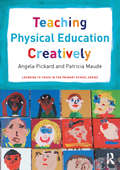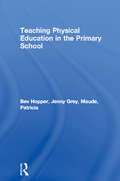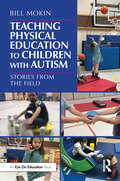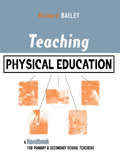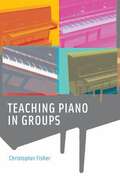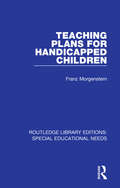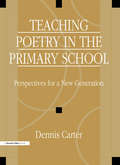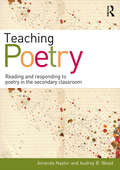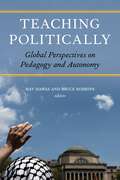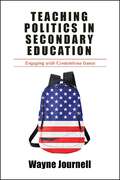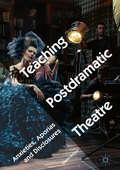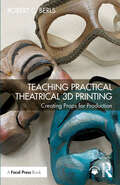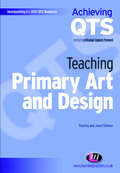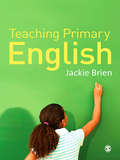- Table View
- List View
Teaching Physical Education Creatively
by Patricia Maude Angela PickardTeaching Physical Education Creatively provides knowledge and understanding in order to engage creatively with the primary Physical Education curriculum for both trainee teachers and qualified teachers. It is full of ideas for developing the teaching of dance, games, gymnastics and outdoor and adventurous activities in an innovative and engaging manner. With an emphasis on developing creative teaching processes by building from children’s curiosity, imagination and need to explore and move, it forges clear links between research and practice, and offers suggestions for developing exciting, engaging new approaches to teaching physical education. Key topics explored include: Physical Competence and Physical Literacy Creative ways to develop the teaching of dance, games, gymnastics and outdoor and adventurous activities Developing understanding of space, speed and dynamics Creative lesson planning Inclusive approaches and aspects of differentiation Teaching Physical Education Creatively presents the theory and background necessary to develop a comprehensive understanding of creative teaching and children’s learning.? Packed with practical guidance and inspiration for lively, enjoyable physical education, it is an invaluable resource for undergraduate and postgraduate students in initial teacher training, practicing teachers, and undergraduate students of physical education.
Teaching Physical Education Creatively (Learning to Teach in the Primary School Series)
by Patricia Maude Angela PickardThis fully updated second edition of Teaching Physical Education Creatively provides knowledge and understanding for students, trainee and qualified teachers, to engage creatively in teaching primary Physical Education. It is full of ideas for developing the teaching of dance, games, gymnastics and ways of using outdoor spaces for activities in an innovative and engaging manner. There is also a chapter to support creative practitioner to plan for creative Physical Education. With an emphasis on developing creative teaching processes by building from children’s curiosity, imagination and need to explore and move, it forges clear links between research and practice, and offers suggestions for developing exciting, engaging new approaches to teaching Physical Education. Key topics explored include: Physical Education and creativity Building physical competence and physical literacy Creative ways to develop the teaching of dance, games, gymnastics and ways of using outdoor spaces for activities Developing understanding of space, speed and dynamics Creative planning Inclusive approaches and aspects of differentiation Teaching Physical Education Creatively presents the theory and background necessary to develop a comprehensive understanding of creative teaching and children’s learning. Packed with practical guidance and inspiration for lively, enjoyable Physical Education, it is an invaluable resource for undergraduate and postgraduate students in initial teacher training, practicing teachers, and undergraduate students of Physical Education and dance.
Teaching Physical Education in the Primary School
by Bev Hopper Jenny Grey Patricia MaudeThis book includes information on all six areas of the PE National Curriculum (games, gymnastic activities, dance, swimming, outdoor and adventurous activities, athletic activities), to increase subject knowledge and to develop teaching, management and planning skills.This book provides professional development for generalist primary teachers and student-teachers and also offers support to subject leaders charged with the responsibility for other colleagues. It will build on current practice and aim to increase knowledge, understanding, confidence and enthusiasm in an area of the curriculum which often receives a very short time allocation during initial teaching training courses.Teaching Physical Education in the Primary School is a comprehensive guide to the subject for primary educators. It deals with not only the teaching and learning of PE, but also everything that is relevant to co-ordinating the subject.
Teaching Physical Education to Children with Autism: Stories from the Field
by Bill MokinThis book is an essential guide for how to teach fun and engaging physical education classes tailored to include the needs of autistic children and children with learning disabilities.With this practical guidebook detailing tested methods and best practices, teachers will be well equipped to support all students, including disabled students and those with varying support needs. Through a narrative lens that details children’s real-life journeys, and with key definitions and ready-to-use activities included throughout, Teaching Physical Education to Children with Autism presents a teacher’s first-hand account of what it’s like to teach students with diverse learning needs. Its comprehensive scope addresses all the practical challenges that educators may face in working with this population, including difficult behavior and disengagement. Detailing a myriad of solutions to try, along with flexible frameworks that can be applied to a myriad of physical education goals, this book is essential reading for any physical education teacher, special education teacher, and anyone wishing to create more equitable learning environments for children with varying learning needs.
Teaching Physical Education to Children with Special Educational Needs and Disabilities
by Philip Vickerman Anthony MaherTeaching Physical Education to Children with Special Educational Needs and Disabilities provides a thorough overview of the challenges and opportunities for inclusion in PE lessons. Combining a theoretical framework with practical strategies for teachers, the title covers a diverse range of issues which teachers need to address to provide high quality learning experiences for children with SEND. This second edition is grounded in up-to-date research on inclusion and has been fully updated in line with the SEND Code of Practice and Ofsted Inspection Framework. It seeks to demystify the statutory responsibilities placed upon teachers and schools to include children with SEND and offers practical examples of how PE teachers can make use of different strategies to differentiate through their planning and assessment. A new chapter explores the importance of consulting with and empowering children with SEND, and additional focus is given to how teachers can work together with SENCOs and LSAs to develop an inclusive culture in PE lessons. Written in an accessible style with reflective tasks in each chapter, this unique text clearly outlines relevant practice-based evidence to fully include children with SEND in PE lessons. This will be essential reading for teachers and school leaders and will enable PE teachers to plan and deliver inclusive lessons for all children.
Teaching Physical Education: A Handbook for Primary and Secondary School Teachers
by Richard BaileyDesigned for all trainee and newly qualified teachers, teacher trainers and mentors, this volume provides a contemporary handbook for the teaching of physical education, covering Key Stages 2, 3 and 4 in line with current DfEE and TTA guidelines.
Teaching Physical Education: Contemporary Issues for Teachers, Educators and Students
by Gary StidderThis book assesses the landscape of physical education today and the issues that shape it as a curriculum subject, particularly in the era of COVID-19. It explores the processes of transformation and change that follow government policy and considers what this means for physical education practitioners in schools. The book covers a wide range of important issues, across (micro-)political, social-cultural, historical and post-modernist categories. Bringing together current research with autobiographical and anecdotal reflections on the realities of PE teaching, it considers the significance of issues such as the emphasis on competitive sport in schools, the socialization of teachers, the influence of politics and policy on the classroom, colonization and decolonization of the curriculum, digital technologies, the health and well-being agenda and the impact of the COVID-19 pandemic. Offering a unique set of critical perspectives on physical education today, this book is essential reading for any physical education course, for all teacher training programmes with a PE track and for all practising teachers, teacher educators or policy-makers with a professional interest in PE.
Teaching Piano in Groups
by Christopher FisherThis book provides a one-stop compendium of information related to all aspects of group piano teaching. <p><p> Motivated by an ever-growing interest in this instructional method and its widespread mandatory inclusion in piano pedagogy curricula, the author highlights the proven viability and success of group piano teaching, and arms front-line group piano instructors with the necessary tools for practical implementation of a system of instruction in their own teaching. <p><p> Contained within are: a comprehensive history of group piano teaching; accessible overviews of the most important theories and philosophies of group psychology and instruction; suggested group piano curricular competencies; practical implementation strategies; and thorough recommendations for curricular materials, instructional technologies, and equipment. The book also addresses specific considerations for pre-college teaching scenarios, the public school group piano classroom, and college-level group piano programs for both music major and non-music majors. <p><p> This book is accompanied by an extensive companion website, featuring a multi-format listing of resources as well as interviews with several group piano pedagogues.
Teaching Plans for Handicapped Children (Routledge Library Editions: Special Educational Needs #38)
by Franz MorgensternFirst published in 1981. Teaching handicapped children confronts us with the challenge of having to plan, deliberately and systematically, how to teach a child to look, listen, move, explore, play, relate to others and to understand and speak their own language – all skills which do not normally have to be taught at all. This book, based on a lifetime’s experience of working with handicapped people of all ages, provides a basic understanding of the effects of a handicap on a child’s development.
Teaching Poetry in a Digital World: Inspiring Poetry Writing through Technology in Grades 6-12
by Stefani Boutelier Sarah J. DonovanTeaching Poetry in a Digital World supports English language arts (ELA) educators for grades 6–12 to incorporate digital literacy in their classrooms by teaching the reading and writing of poetry.In an increasingly digital age, educators must adapt to meet the changing needs and interests of their students by incorporating technology into the classroom. This book introduces its audience to the e-Poetry Framework. This framework demonstrates how poetry might present itself in a literacy-based unit with the benefit of a technology medium to share with the world. Examples include teaching zip-ode poetry, incorporating haiku with the creation of GIFs, and ethically discussing AI with nonet poems. With adaptable lesson plans and assessments, as well as educator examples, the book will inspire teachers to create intentional student-centered e-Poetry units.The book is aligned with ELA literacy standards, International Society for Technology in Education (ISTE) educator standards, and National Council of Teachers of English (NCTE)’s position statement for integrating technology into ELA classrooms. It is a key resource for secondary school educators teaching ELA, creative writing, and digital media.
Teaching Poetry in the Primary School: Perspectives for a New Generation
by David CarterFirst Published in 1999. Routledge is an imprint of Taylor & Francis, an informa company.
Teaching Poetry: Reading and responding to poetry in the secondary classroom
by Amanda Naylor Audrey B. WoodTeaching Poetry is an indispensible source of guidance, confidence and ideas for all those new to the secondary English classroom. Written by experienced teachers who have worked with the many secondary pupils who ‘don’t get’ poetry, this friendly guide will help you support pupils as they access, understand, discuss and enjoy classic and contemporary poetry. With an emphasis on active approaches and the power of poetry to enrich the lives of both teachers and students, Teaching Poetry: Provides a succinct introduction to the major ideas and theory about teaching poetry Covers the key genres and periods through tried and tested favourites and a range of less well known new and historical poetry Illustrates good practice for every approach covered, through case studies of theory and ideas in action in the classroom Includes activities, ideas and resources to support teaching at Key Stages 3, 4 and 5. Teaching Poetry tackles head on one of the aspects of English teaching that new and experienced teachers alike find most difficult. It offers both a comprehensive introduction to teaching poetry and a rich source of inspiration and support to be mined when faced with an unfamiliar text or an unresponsive class.
Teaching Politically: Global Perspectives on Pedagogy and Autonomy
by May Hawas and Bruce RobbinsCulture is inextricable from politics. This includes the politics of who we are, as teachers, intellectuals, writers, cultural workers, and students, and what we want to bring to and take from the site of instruction. It also includes the politics of who we want to be, as citizens, professionals, and active contributors to our communities and to the world in general, and what we can be, realistically, in the particular contexts in which we live. Teaching Politically addresses some of the political constraints that shape our pedagogical spaces, especially in the teaching of literature. The book brings together a global group of academics, activists, public intellectuals, poets, and novelists to examine the way politics manifest pedagogically, and how a commitment to educating manifests politically, in and beyond the classroom. At the heart of the discussion is how political and professional paradigms chafe against, intersect with, or otherwise become inseparable from each other in any vocation that attempts to educate: from writing, journalism, and public speaking to art, activism, and medicine.Contributors: Dimitris Christopoulos, Dimitri Dimoulis, Khaled Fahmy, Rishi Goyal, May Hawas, Bonnie Honig, Mona Kareem, Benjamin Mangrum, Nora Parr, Bruce Robbins, Ahdaf Soueif, Omid Tofighian, Elahe Zivardar
Teaching Politics in Secondary Education: Engaging with Contentious Issues
by Wayne JournellWinner of the 2018 Exemplary Research in Social Studies Award presented by the National Council for the Social StudiesMany social studies teachers report feeling apprehensive about discussing potentially volatile topics in the classroom, because they fear that administrators and parents might accuse them of attempting to indoctrinate their students. Wayne Journell tackles the controversial nature of teaching politics, addressing commonly raised concerns such as how to frame divisive political issues, whether teachers should disclose their personal political beliefs to students, and how to handle political topics that become intertwined with socially sensitive topics such as race, gender, and religion. Journell discusses how classrooms can become spaces for tolerant political discourse in an increasingly politically polarized American society. In order to explore this, Journell analyzes data that include studies of high school civics/government teachers during the 2008 and 2012 presidential elections and how they integrated television programs, technology, and social media into their teaching. The book also includes a three-year study of preservice middle and secondary social studies teachers' political knowledge and a content analysis of CNN Student News.
Teaching Postdramatic Theatre: Anxieties, Aporias and Disclosures
by Glenn D’CruzThis book explores the concept and vocabulary of postdramatic theatre from a pedagogical perspective. It identifies some of the major anxieties and paradoxes generated by teaching postdramatic theatre through practice, with reference to the aesthetic, cultural and institutional pressures that shape teaching practices. It also presents a series of case studies that identify the pedagogical fault lines that expose the power-relations inherent in teaching (with a focus on the higher education sector as opposed to actor training institutions). It uses auto-ethnography, performance analysis and critical theory to assist university teachers involved in directing theatre productions to deepen their understanding of the concept of postdramatic theatre.
Teaching Postwar Japanese Fiction (Options for Teaching #60)
by Alex BatesAs Japan moved from the devastation of 1945 to the economic security that survived even the boom and bust of the 1980s and 1990s, its literature came to embrace new subjects and styles and to reflect on the nation's changing relationship to other Asian countries and to the West. This volume will help instructors introduce students to novels, short stories, and manga that confront postwar Japanese experiences, including the suffering caused by the atomic bombings of Hiroshima and Nagasaki, the echoes of Japan's colonialism and imperialism, new ways of thinking about Japanese identity and about minorities such as the zainichi Koreans, changes in family structures, and environmental disasters. Essays provide context for understanding the particularity of postwar Japanese literature, its place in world literature, and its connections to the Japanese past.
Teaching Practical Theatrical 3D Printing: Creating Props for Production
by Robert C. BerlsTeaching Practical Theatrical 3D Printing: Creating Props for Production is a cohesive and practical guide for instructors teaching 3D printing techniques in stagecraft, costume and props courses.Written for the instructor, this book uses non-technical language to explain 3D printers, their workflows and products. Coverage includes the ins and outs of multiple filaments, pros and cons of different types of printers, shop or laboratory setup and safety concerns. The book features lesson plans, rubrics and class-tested sample student projects from design to finished product that highlight learning objectives and methodologies, as well as software and hardware usage explanations and common problems that can occur within design and printing. Step-by-step instructions are included for many types of projects, including fake noses, candlestick phones, buttons, 3D scans, historical recreations and linear actuators. The book also contains examples of poor, average and excellent work with grading explanations and guidance on how to help the student move to the next level with their projects. Chapter objectives, chapter summaries, checklists and reflection points facilitate an instructor in gaining confidence with 3D printers and incorporating their use in the classroom.Teaching Practical Theatrical 3D Printing is an excellent resource for instructors of Props and Costume Design and Construction courses that are interested in using state of the art tools and technology for theatre production.Fully editable files for every object featured in the book are available at www.routledge.com/9781032453279, allowing readers to jump-start their projects and giving them the flexibility to change and redesign the items to best fit their needs.
Teaching Practice for Early Childhood: A Guide for Students
by Rosemary PerryThis fully updated new edition of Teaching Practice for Early Childhood will help student and recently graduated early childhood teachers make the most of their teaching in a variety of early years' settings. Chapters cover vital topics such as ways of knowing and relating to children, the early childhood curriculum, and working collaboratively with colleagues and parents.In addition, this new edition takes into account the current demands for quality, accountability and continuity in the early childhood curriculum, and includes fresh material on: the importance of social and emotional development the role of observation in assessing children's learning and growing, and the use of documentation as a form of accountability and teacher research the value of socially responsive learning environments. This authentic, trustworthy and engaging text is written in a style that talks directly to its readers. By presenting the experiences of student teachers, as well as those of beginning and experienced teachers, the author brings into focus real situations, dilemmas, issues and rewards which student teachers are likely to face.
Teaching Practices from America's Best Urban Schools: A Guide for School and Classroom Leaders
by Cynthia L. Uline Joseph F. Johnson, Jr. Lynne G. PerezDiscover the teaching practices that make the biggest difference in student performance! The new edition of this practical, research-based book gives leaders and teachers an even closer look at instructional practices from top award-winning urban schools. With refreshed examples from high-performing teachers and detailed analyses of these practices, the authors demystify the achievement of these schools while offering a practical guide to help educators apply these practices in their contexts. Teaching Practices from America's Best Urban Schools is a valuable tool for any educator in both urban and non urban schools that serve diverse student populations, including English language learners and children from low-income families. What’s New: Additional "What It Is/What It Isn’t" boxes help educators distinguish the subtle differences in the implementation of practices that lead to impressive learning results "Practice Guides" and "Practical Next Steps" for each of the 8 Success Factors encourage self-assessment and collaboration Expansion of topics address current developments in education and additional examples from award-winning elementary, middle, and high schools provide new insights.
Teaching Primary Art
by Jean EdwardsTeaching Primary Art is an introductory textbook for those training to teach and support learning in art in the primary school. The book first explores the underpinning philosophy and pedagogy of teaching and learning art, including why we teach it; planning and assessment; and teaching and support strategies. Then it covers the practical aspects of teaching art, including a list of useful vocabulary to encourage talk around art and links to cross-curricular learning.
Teaching Primary Art and Design
by Susan OgierTrainee and beginning teachers often find it hard to plan for and teach good art lessons as there is little guidance on subject knowledge and outstanding practice. This key text will provide primary trainee teachers with subject knowledge, expert advice and guidance along with practical solutions that are necessary to offer children the best possible experiences in art, craft and design, to ensure that they have access to a broad and balanced curriculum. Through guidance and support it will enable them to develop an understanding of the principles and values that underpin high standards and high expectations, and show good progress in the subject.
Teaching Primary Art and Design (Achieving QTS Series)
by Paul Key Jayne StillmanThis book introduces trainees and newly qualified primary teachers to the teaching of art and design in primary schools. It helps students gain an appreciation of what constitutes good practice in primary art and design and how they can go about achieving it. To meet the different needs of students, the book identifies varying levels of experience, creativity and confidence, and offers suggestions for applying these levels to the classroom. The book covers key areas of the art and design curriculum for Early Years Foundation Stage, Key Stage 1 and Key Stage 2, considering both their discrete and developmental characteristics.
Teaching Primary Drama
by Brian WoollandAssuming no prior knowledge or experience of drama teaching, Brian Woolland'sTeaching Primary Drama offers a comprehensive introduction to the teaching of drama in the primary school, and focuses on current initiatives in primary education including the primary literacy strategy.The text is an invaluable resource for any teacher wishing to adopt a creative approach to teaching in their classroom. It offers guidance on different drama methods, and each practical idea translates to all areas of the curriculum."[Teaching Primary Drama] is written in simple terms, uncluttered by references, is refreshingly straightforward and succinct and does not fall into the trap of making a complex subject sound complex; a trait of some texts which can push non-specialists away."Amanda Kipling, London Drama Magazine, Summer 2010 issue.
Teaching Primary English
by Jackie BrienShortlisted for the UKLA Academic Book Award 2013! Literacy empowers learning across the whole curriculum and language is at the centre of all learning in primary education. Aware of current curriculum developments and drawing from the latest research Teaching Primary English encourages teacher education students to develop a deeper understanding of the essential issues involved in teaching English in order to approach a career in the primary classroom with the confidence and knowledge required to succeed. Taking a fresh approach to the main elements of teaching primary English, Jackie Brien strikes an engaging balance between the practical requirements of English teaching and encouraging informed reflection on key aspects of primary literacy. This is essential reading for everyone studying primary English on primary initial teacher education courses including undergraduate (BEd, BA with QTS), postgraduate (PGCE, SCITT), and employment-based routes into teaching. Jackie Brien is Curriculum Leader for English, Communication, Language and Literacy at the University of Chester.
Teaching Primary English in Australia: Subject Knowledge and Classroom Practice
by Eve Bearne David Reedy Paul Gardner Yvonne SawersThis first Australian edition of Teaching Primary English has been updated and adapted to reflect the Australian sociocultural and educational context. This text provides a comprehensive, evidence informed introduction to teaching and learning English in the primary school classroom. New content refers to the Australian English Curriculum and incorporates Aboriginal and Torres Strait Islander perspectives and literacy perspectives relevant to the Asia-Pacific region as well as the broader international context. This edition also includes a new section devoted to visual literacy, critical literacy and multimodality. Teaching advice and ideas are supported by practical examples linked to video clips filmed in real schools, reflective activities, observational tasks and online resources. Each section includes suggestions for great children’s literature and offers assessment advice and support for planning for diversity and special educational needs. Drawing on the very latest research and theory, supported by practical examples and guidance, this is an essential resource for pre-service teachers as they develop subject knowledge and the skills and confidence to deliver effective and engaging classroom practice.
